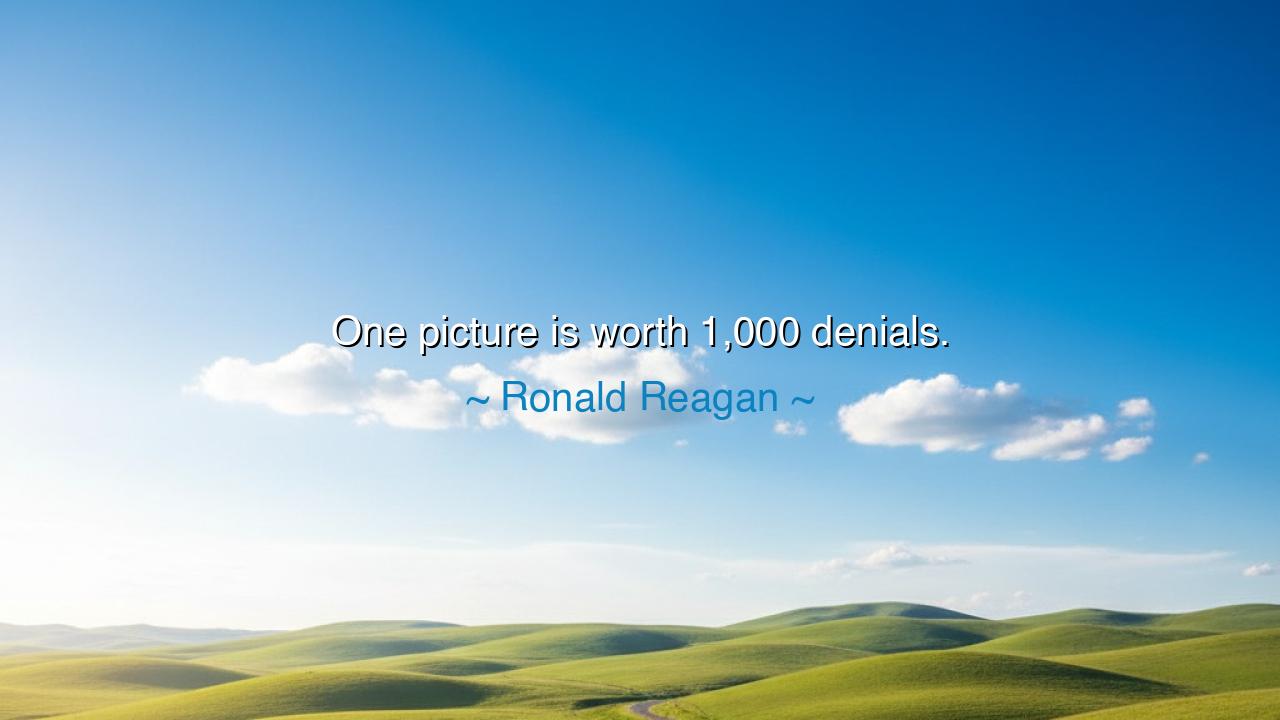
One picture is worth 1,000 denials.






In the words of Ronald Reagan, “One picture is worth 1,000 denials.” This evocative statement speaks to the power of visual evidence—how a single image can transcend words, bypassing the defenses of logic and reason to speak directly to the emotions and perceptions of those who behold it. Reagan’s insight reflects an ancient truth that images, symbols, and representations hold a deep, irrefutable power. No amount of verbal denial or rational argument can diminish the truth captured in an image, for it speaks in a language that is universal and often more truthful than words themselves.
In the ancient world, symbols were the vessels of truth and meaning. The Egyptians, for example, built monumental structures like the pyramids and adorned their tombs with images that conveyed powerful messages of eternity and divinity. These visual representations were not merely artistic—they were a means of communicating truths that went beyond the grasp of language. The image of the pharaoh—strong, immortal, and eternal—told a story far more compelling than any proclamation made by a king. Through these images, the pharaoh's power was etched into the collective memory of the people, impervious to the shifting tides of politics or dispute. Reagan’s statement underscores this idea: a picture carries within it an undeniable truth, one that words cannot easily diminish.
Consider, too, the ancient Greeks, who understood the power of visual storytelling in their myths and art. The tale of Perseus and Medusa, depicted in countless works of art, carried a deep moral truth that transcended the written word. When Perseus holds the severed head of Medusa, the image communicates far more than the event itself; it embodies the triumph of reason and courage over chaos and danger. Through the image, the truth is conveyed not just by the narrative, but by the symbol itself. Reagan’s words echo this ancient understanding: sometimes, a single image—whether an iconic photograph or a powerful symbol—can convey a truth that denials or explanations cannot touch.
In the modern era, the impact of visual imagery has only grown stronger. Consider the historic photograph of the Vietnam War, which showed a young girl, Kim Phuc, running down a road, her body burned by napalm. The image captured the horror and suffering of war in a way that no political speech or diplomatic discussion could ever do. The truth of that moment, encapsulated in a single frame, transcended the words of politicians who may have tried to explain or justify the violence. Like the ancient symbols, the image carried a universal message—one that resonated with the hearts of millions across the world. It is a reminder that images, when they capture truth, become more powerful than the most eloquent arguments or the most insistent denials.
This lesson was learned by leaders and storytellers throughout history, but none perhaps more dramatically than Winston Churchill during World War II. Churchill understood the importance of symbolism in the fight for the hearts and minds of the people. He used images—such as the famous photograph of him standing defiantly in front of 10 Downing Street—to embody the spirit of resistance against tyranny. His words were powerful, but it was the image of a man resolute in the face of danger that captured the collective imagination. Churchill knew that a picture of courage in the midst of adversity could inspire more than a thousand speeches.
The lesson in Reagan’s words is clear: visuals are more than mere representations of reality—they are powerful tools of truth and influence. The words we speak, though important, are often susceptible to manipulation, misinterpretation, or denial. But a single image—honest, raw, and unfiltered—can bypass these obstacles and speak directly to the core of human understanding. This truth holds power not just in politics but in every corner of life. Reagan’s reminder is that we must be vigilant about the power of images and their ability to shape our perceptions of truth.
In your own life, remember the power of what you see, and be conscious of how images shape your view of the world. Whether through the news, art, or the people you encounter, visuals hold immense power to influence, inspire, and challenge your beliefs. Choose to engage with images that communicate truth and encourage awareness and action. Understand that while words may be contested and debated, the images that we allow into our hearts and minds are often the ones that shape our worldviews and our actions. And like the ancients, let us use the power of visuals to tell stories that transcend the limitations of language, communicating truths that resonate deeply within the soul.






AAdministratorAdministrator
Welcome, honored guests. Please leave a comment, we will respond soon